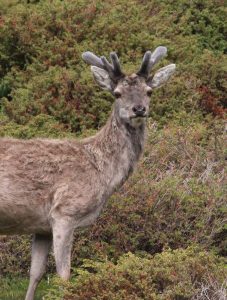 The native red deer in the Highlands, both hinds and stags, will face problems in the next few weeks particularly as the winter lasted so long this year. For much of the year the hinds and stags occupy the same areas but now the hinds will have move into their own areas, sometimes on the higher ground. For many hinds these are traditional grounds where they have their calves and the stags generally stay away from such areas. One of the problems the hinds face this year is their condition as the first bite of fresh grazing did not come until later than usual, especially on the higher ground. Some hinds will have already had their calves whilst others will not drop them until next month. Fortunately the red deer hinds normally only have one calf, unlike the roe deer that will often have twins.
The native red deer in the Highlands, both hinds and stags, will face problems in the next few weeks particularly as the winter lasted so long this year. For much of the year the hinds and stags occupy the same areas but now the hinds will have move into their own areas, sometimes on the higher ground. For many hinds these are traditional grounds where they have their calves and the stags generally stay away from such areas. One of the problems the hinds face this year is their condition as the first bite of fresh grazing did not come until later than usual, especially on the higher ground. Some hinds will have already had their calves whilst others will not drop them until next month. Fortunately the red deer hinds normally only have one calf, unlike the roe deer that will often have twins.
Once the hinds have had their calves they are very attentive to them and there is a great deal of licking and small talk from the hind to the calf. There is also a complex social system where although a group of hinds and calves may look rather scattered there is a complex relationship. For example, it may appear that a calf is a long way from its mother but there will always be a hind on the watch over such calves no matter how far the mother may wander. So the hind behaviour is highly social and not more so than when they face a predator whether it be a fox, golden eagle or, presumably now, a white tailed eagle. Hinds will charge at would be predators, even the eagles, but there is no doubt that a number of calves are taken by such predators.
The stags also have problems. They will have had to recover from the rut of last Autumn and so will have gone into the winter in poor condition and last winter did not help them as it was so long. The larger stags have already cast their antlers which are shed annually and regrown in time for the rut next Autumn. The cast antlers are often chewed by both hinds and stags for the bone calcium. However, that is if they get the chance as antlers are still very much a commercial product in their sale for a variety of items from handle’s to walking sticks. This makes a perk for the stalkers and it is interesting that it is illegal for anyone other than the landowner or someone credited by him to collect the cast antlers. Whilst on a live deer they belong to no-one but once cast or on a dead stag then it is another matter.
Re-growing antlers takes it out of a stag but there is also the problem of the covering of the growing antlers. This is called velvet and close to can be seen to be partly made of hairs that are tightly packed and look and feel like velvet, hence the name. The photograph shows an early growth of antlers covered by velvet. The problem is that this velvet is very sensitive and can easily be damaged and must be protected at all times Any damage can affect the growth of the final hard antler. So any jostling, real or pretend fighting or sparring must be avoided at all costs. The answer, if there is to be any aggression, is for the stags to rear up on their hind legs and box with their front legs. It is rather like when brown hares are boxing but with such a large mammal as a red deer it looks really incongruous.
Tags: highland wildlife
